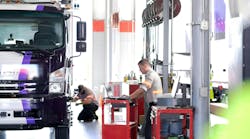Remember when you used to roll up your car's passenger-side window to avoid offensive noise as you passed a large truck? In case you haven't noticed, you hardly ever have to do this anymore. First, most modern autos incorporate better noise isolation materials and sealing systems. Second, they're equipped with vastly improved heating and air conditioning systems that result in the windows remaining closed, regardless of the outside temperature.
But perhaps most important of all, trucks themselves are much, much quieter. The three vehicle systems primarily responsible are exhaust, engine cooling fans, and tires.
Nearly all highway diesels are now turbocharged. Fresh exhaust gases pass through the turbo, where sound level peaks are dampened as exhaust flow drives the compressor side of the turbine. This creates an effective sound damper ahead of the muffler.
Acoustics engineering has also been applied to the modern engine block, manifold, and intercooler designs to lower noise levels even further, in spite of climbing horsepower and torque ratings.
Cooling fans can also be very noisy, but they're usually required only under low road speed conditions in hot weather. Therefore, modern trucks are fitted with clutch driven fans that normally freewheel and are engaged (and thus noisy) only when needed for additional airflow through the radiator.
Modern truck tires also contribute significantly to reduced noise levels. Total tire noise is made up of numerous components. Air pumping, tread element vibration, casing vibration, and acoustic resonance are four of the noise generation mechanisms examined when evaluating new designs. The measurement unit used to quantify noise, or sound energy level, is decibel (dB); a special weighting scale, the dB(A) scale, approximates sound energy level as heard by the human ear.
Although much progress has been made in minimizing noise generation mechanisms, we can't ignore road surfaces' prominent role in tire noise. Numerous tests have shown highway rib truck tires to be up to 8 dB(A) higher on new brushed concrete than on moderately smooth concrete roads. Remember, a 3 dB(A) difference is equivalent to doubling the sound energy level.
Typical road surfaces are an important part of new tire sound level design today. It has been demonstrated that a perfectly smooth tire, with no grooves or tread design, creates more noise, measured in db(A), on some highway surfaces than a properly designed rib tire. Tire sound levels also increase with speed, and testing is usually conducted at highway speeds, following detailed procedures and controlling ambient conditions to minimize non-tire variables.
Power-off, coast-down conditions, where sound levels are measured through a narrow speed range, are typical of industry testing. This science has given tire engineers more flexibility to experiment with aggressive new designs, tread depths, and stabilizing tie bars.
But let's not forget the role of irregular treadwear, which nearly always increases tire noise levels. Engineering efforts haven't been able to eliminate this tendency, so it has become a maintenance issue.
Proper inflation pressure, total vehicle alignment, and dual tire matching (by size and inflation) will minimize irregular wear, keeping tire noise to a minimum.
One final thought relates to retreads. As with new tires, it's nearly impossible for anyone other than acoustics engineers to assess the noise properties of tire designs by looking at them. For example, many retread designs, which appear to have tread patterns identical to new tires, may have widely varying noise characteristics.


